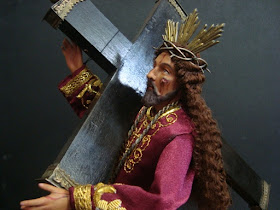
My search for another Purisima Concepcion was spurred by my failure to get an beautiful ivory Mary with intricate silver metalworks and encased in its original (although broken) hurricane glass, complete with a carved topper.
 I’ve never seen an antique santo so complete and available. The price, of course, was a major deterrent, and sadly, I had to pass it up; the Purisima went unsold, even after several price cuts.
I’ve never seen an antique santo so complete and available. The price, of course, was a major deterrent, and sadly, I had to pass it up; the Purisima went unsold, even after several price cuts.
When my favorite dealer called to say that he had an ivory Immaculate Conception for sale, I lost no time in looking it up. The fact that the santo belonged to another seller and that my dealer was just acting as a middleman did not hinder me at all from having a look. On my way to Pampanga, I took a short detour to his shop to check the item.

 When I finally saw it, I was smitten by the antique piece—never mind that it did not have a base and that its metal works have all been lost. Its right foot also had a small missing wooden piece which I easily repaired with clay epoxy.
When I finally saw it, I was smitten by the antique piece—never mind that it did not have a base and that its metal works have all been lost. Its right foot also had a small missing wooden piece which I easily repaired with clay epoxy. The head was of white ivory, of very good quality. The facial carving was excellent, depicting Mary at a tender age. It was outfitted with glass eyes and a human hair wig. It’s surprising that her long tresses were intact, save for a few thinning strands.
The head was of white ivory, of very good quality. The facial carving was excellent, depicting Mary at a tender age. It was outfitted with glass eyes and a human hair wig. It’s surprising that her long tresses were intact, save for a few thinning strands.
In contrast, the hands were carved in the basic “tinidor” (fork-like) style, with almost straight fingers with little definition. All fingers, however, were intact.

Remarkable too were here pierced ears—one ear still retained minute dangling earrings of gold and mother-of-pearl.
 The vestments, though badly tattered and frayed, had most of the gold thread embroidery, which meant that they could be transferred on new fabric. There were quite a number of interesting details on her satin dress. On her chest was embroidered the Virgin’s monogram, AVM.
The vestments, though badly tattered and frayed, had most of the gold thread embroidery, which meant that they could be transferred on new fabric. There were quite a number of interesting details on her satin dress. On her chest was embroidered the Virgin’s monogram, AVM.

Sewn on the hem of her vestment was a small brass sun with a smiling face, which, on a regular ivory santo, would be a separate metal piece wired to the base.
 It took some time for me to have the image restored by Dr. Raffy Lopez. First to be made was the globe base—which was an exact copy of the base of the Purisima that got away. The base had side trims of flower-and-leaf motif, with a serpent looped around it.
It took some time for me to have the image restored by Dr. Raffy Lopez. First to be made was the globe base—which was an exact copy of the base of the Purisima that got away. The base had side trims of flower-and-leaf motif, with a serpent looped around it.
The vestments were exact patterns of her original clothes. The intricate embroidery was salvaged and re-sewn on an old, faded white satin, while the long shoulder cape was done in blue.

Meanwhile, the metalworks were designed ordered from metalsmith Dodong Azares. I opted for a simple 12-star halo, matched with a more complex Marian ‘corona’.

 The biggest challenge was replicating the tiny, delicate earrings. Raffy’s jeweler friend, Noel Menguito, came to the rescue by painstakingly replicating the design of the original earrings in gold.
The biggest challenge was replicating the tiny, delicate earrings. Raffy’s jeweler friend, Noel Menguito, came to the rescue by painstakingly replicating the design of the original earrings in gold. The final improvement was giving more volume to the long, but thinning hair of the Purisima using real human hair extensions. Mounted on its new base, my Purisima Concepcion was finally completed after over two months of restoration, ready to be taken home.
The final improvement was giving more volume to the long, but thinning hair of the Purisima using real human hair extensions. Mounted on its new base, my Purisima Concepcion was finally completed after over two months of restoration, ready to be taken home. Standing next to my more elaborate ivories, my Purisima looks simple enough, the way a young Mary should be—no fancy frills, no extraneous accessories--giving credence to the saying that indeed, simplicity is beauty, pure and true.
Standing next to my more elaborate ivories, my Purisima looks simple enough, the way a young Mary should be—no fancy frills, no extraneous accessories--giving credence to the saying that indeed, simplicity is beauty, pure and true.


























